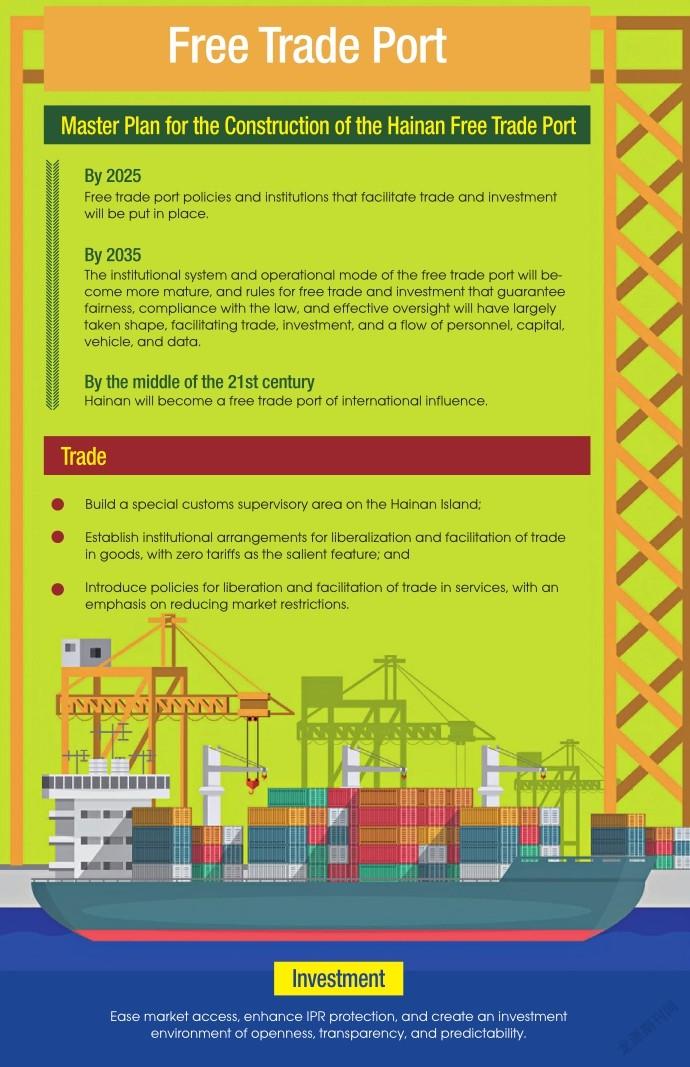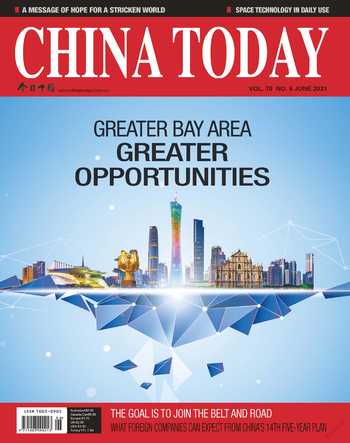Hainan,a Magnet for Foreign Investment
By LI JIE

IN 2018 the State Council of China approved the establishment of the China (Hainan) Pilot Free Trade Port and released the China (Hainan) Pilot Free Trade Zone General Plan. In the following years, the levels of economic development continued to rise in Hainan, positioning the province as a shining example of China’s opening- up and reform drive, creating new opportunities for people of the region and beyond.
Massive Rise of Development
On April 13, 2018, China’s central government announced support for Hainan in developing the whole island into a pilot free trade zone, and gradually exploring and promoting the establishment of a free trade port with Chinese characteristics. Changes soon swept across Hainan.
“Transport immediately improved,”recalled Ian, a British citizen who has lived in Hainan for 14 years. A direct flight between Sanya, a city at the southern end of the province, and London was launched in July 2018. “My home is 20-30 minutes from Sanya Airport by car. When I get to the airport, the next stop is London. It is fabulous,” he said. Since his arrival in Hainan in 2007, he has been impressed by the changes that have taken place over the past few years, with transport being upgraded, the Sanya cityscape transformed, people’s living standards raised, and the eco-environment improved.
Behind these changes are a slew of infrastructure, public service, and indus-trial projects. One of them is construction of the island-looping sightseeing highway, which began last December. Driving along it, people will enjoy ocean views on one side and idyllic scenery on the other.
In March this year, the second batch of construction projects for the Hainan Pilot Free Trade Port were launched in Haikou City, Sanya City, and Yangpu Economic Development Zone. The total investment in these 110 projects exceeded RMB 28.9 billion. According to Cong Liang, deputy chief of the National Development and Reform Commission(NDRC), they are part of the key projects in such fields as new infrastructure, transport, and energy planned for Hainan.
“In years past, I usually took vacations abroad. Last year I went to Sanya instead because of the pandemic. I had great fun there and shopped a lot. The trip was exciting,” said Zhang Han, a resident of Beijing. Under new preferential policies, Hainan is appealing to more Chinese like Zhang who were formerly keen on traveling abroad.
After the introduction of a new policy on the island’s offshore duty-free retailing on July 1, 2020, the China Duty Free Group expanded existing stores, set up new outlets, introduced new lines of products, and intensified promotional activities to cater for the growing needs of consumers. At present, the group operates five venues of offshore dutyfree sales, where long queues are regular sights.
Last year offshore duty-free sales reached RMB 30 billion, compared with RMB 15 billion in 2019, disclosed Shen Xiaoming, Party secretary of Hainan and chairman of the standing committee of the provincial people’s congress. The figure is expected to top RMB 60 billion this year.
In addition to retailing, Hainan is poised to have a bigger slice of the medical tourism and international education markets. For this purpose it has established the Hainan Boao Lecheng International Medical Tourism Pilot Zone.
Zero Tariffs
On April 8, 2021, China Shipping & SINOPEC Suppliers Co., Ltd. supplied Feiyunhe, a ship of the Shanghai PANASIA Shipping Co., Ltd., with bonded oil at the Yanpu Port. This was the first transaction of a tax-free oil product in Hainan for a domestic ship carrying goods for both international and domestic trade.
According to their destinations (domestic or foreign), ships in China are eligible for taxed fuel or bonded fuel, whose price difference stands between RMB 700 and RMB 1,300 per ton. Fuel costs account for 30-60 percent of overall operating costs of shipping, it is therefore of great significance to the sector.
In the recent past, Hainan has become the pacesetter in several areas of reform, including exempting tariffs on the import of certain materials and products, cutting tax rates and simplifying the taxation system. These have increased its appeal to investment from other parts of China and the world.
On March 23, a company based in the Boao Lecheng International Medical Tourism Pilot Zone completed customs clearance for a physiotherapy device it imported for self-use, the first of its kind exempted of tariffs. At a price tag of RMB 3.58 million, the exemption was a substantial RMB 830,000.
Also in March, the taxation office of the Yangpu Economic Development Zone released a RMB 117 million ship tax rebate, and the money was deposited into the shipping company’s bank account within 24 hours. Encouraged by favorable policies, more and more large international ships have registered in the Yanpu zone: the number stood at 26 at the end of February 2021, with their carrying capacities adding up to five million tons.
According to Vice Minister of Finance Zou Jiayi, since Hainan introduced the zero-tariff policy for the import of raw and auxiliary materials, the means of transport, and production equipment for self-use last November, the value of imports in these three categories has approached RMB 900 million, and the tariffs exempted exceeded RMB 100 million, a huge saving for businesses concerned.
By tapping both internal growth potential and external resources, Hainan has improved its industrial structure and achieved better-quality development. The share of industrial investment in the overall investment in the region has increased from under 40 percent to above 60 percent, and the main driver of its economic growth has shifted from investment to the duo of consumption and investment. Within a year after the establishment of the Hainan Free Trade Port, the number of newly registered businesses, volume of paid-in foreign investment, and inflow of professionals from out of the region have all doubled.
Soaring Foreign Investment
In early April, the Hainan Maritime Safety Administration issued the compliance certificate to Hainan Laifushi Marine Engineering Management Co., which is the first fully foreign-owned shipping company at the Hainan Free Trade Port. Its investor is Greenland Petroleum Operation Pte. Ltd. from Singapore. Normally the procedure for such certification would have taken 15 days, but in Hainan the period was cut to only three. “It is much faster than registering a similar company in other countries in our experience. During the process, our needs were dealt with promptly,” said the company’s executive.
Since the company needed a compliance certificate to manage an offshore ship from the Marshall Islands engaging in global marine engineering ship safety and pollution prevention management, which would be changed to Chinese nationality, the Hainan Maritime Safety Administration launched a green path for the company and quickly approved its application.
With broader openness, better services, more preferential tax policies, and easier market access, Hainan has seen a strong surge of businesses in various economic sectors. Over the past three years, market entities expanded by 763,000, more than the total over the previous 30 years; paid-in foreign investment doubled annually for three years in a row to reach US $5.27 billion accumulatively, more than half of the sum over the previous 30 years.

“The explosive growth of foreign investment over the past three years is an achievement of the free trade port,” said Hainan Governor Feng Fei. Despite the impact of COVID-19, more than 1,000 foreign companies were established in the province last year, three times the number of 2019. And the source of foreign investment there has extended to 80-plus countries and regions worldwide.
What makes Hainan so attractive? According to Governor Feng Fei, first, the region has the shortest foreign investment negative list in China – with only 27 items compared with 33 on the national list; second, it offers lower tax rates – 15 percent corporate income tax for industrial enterprises encouraged by Hainan and no more than 15 percent personal income tax for high-caliber professionals.
Last year Ian and his wife registered a company in Hainan, and his friends from other countries have similar plans, he said. The bright prospect of the free trade port and success in controlling the pandemic across China have enhanced the international appeal of Hainan.
Ian had planned to move his family to the U.K. when his child reaches school age, but now he has changed his mind after seeing growing opportunities in Hainan, as evidenced by the steady stream of business generated by his young company.

